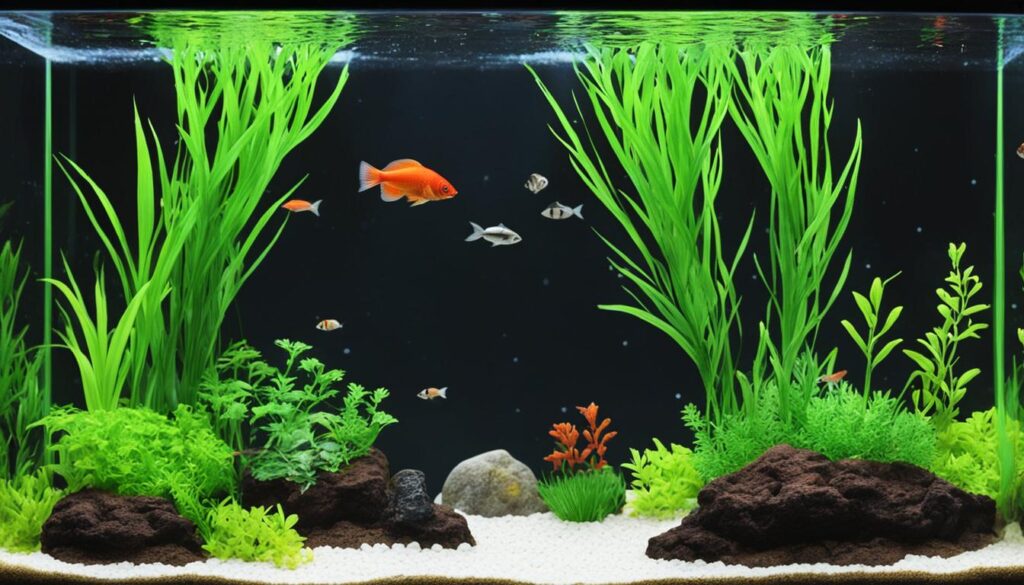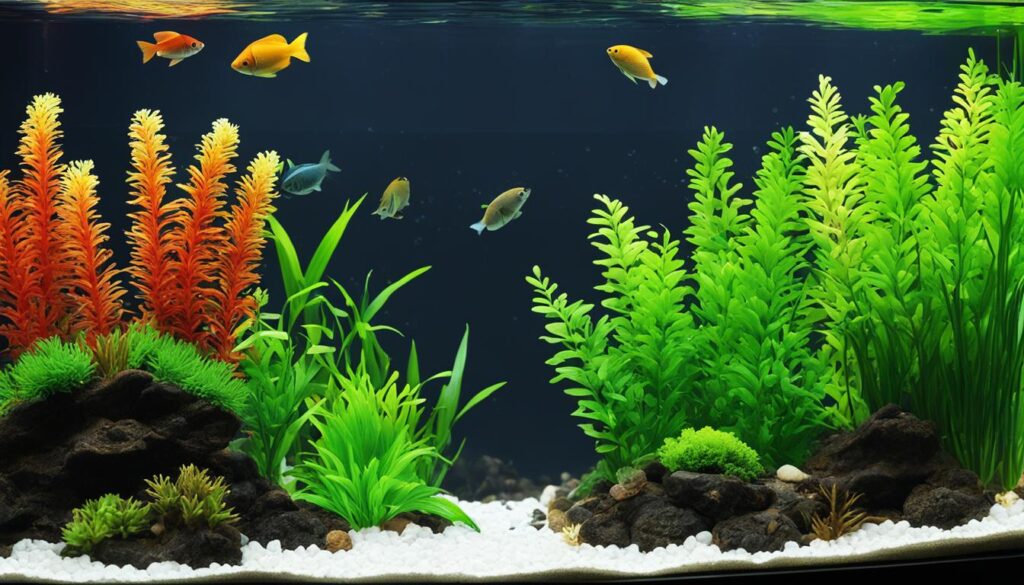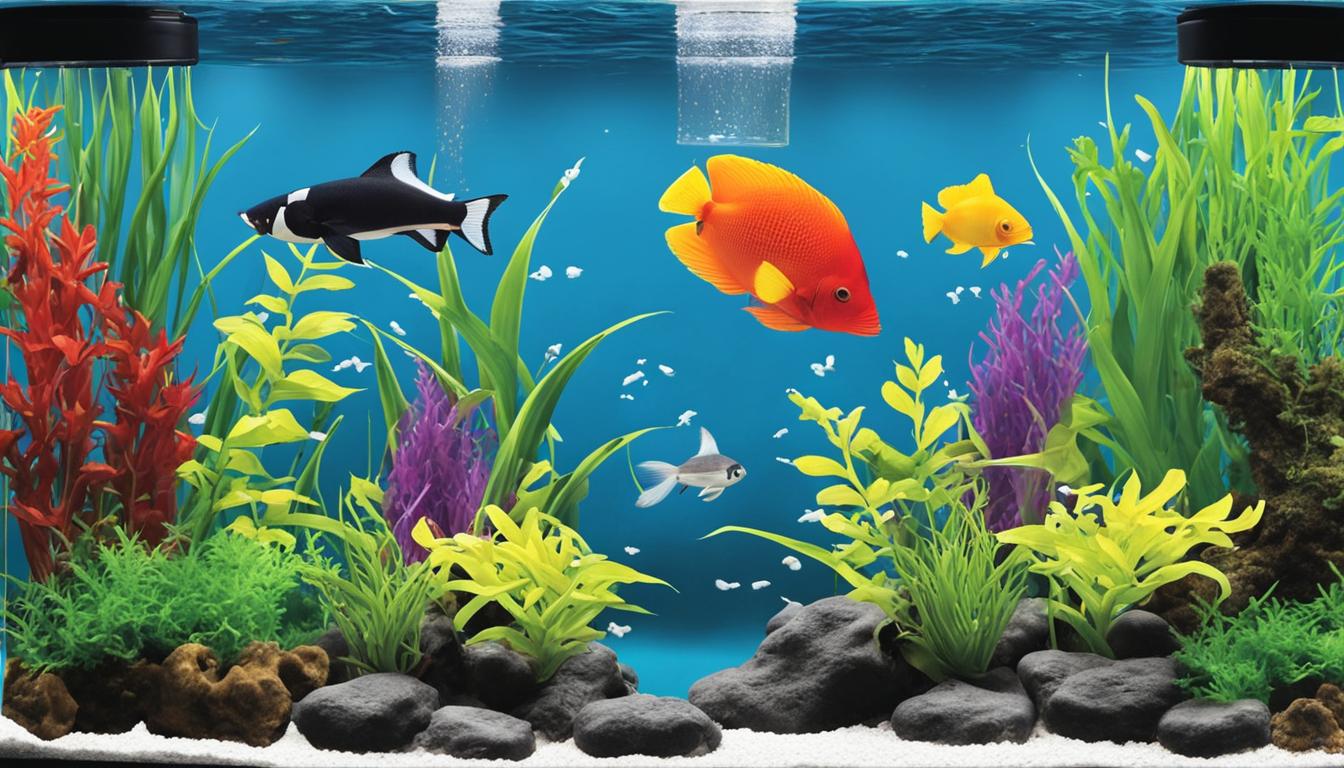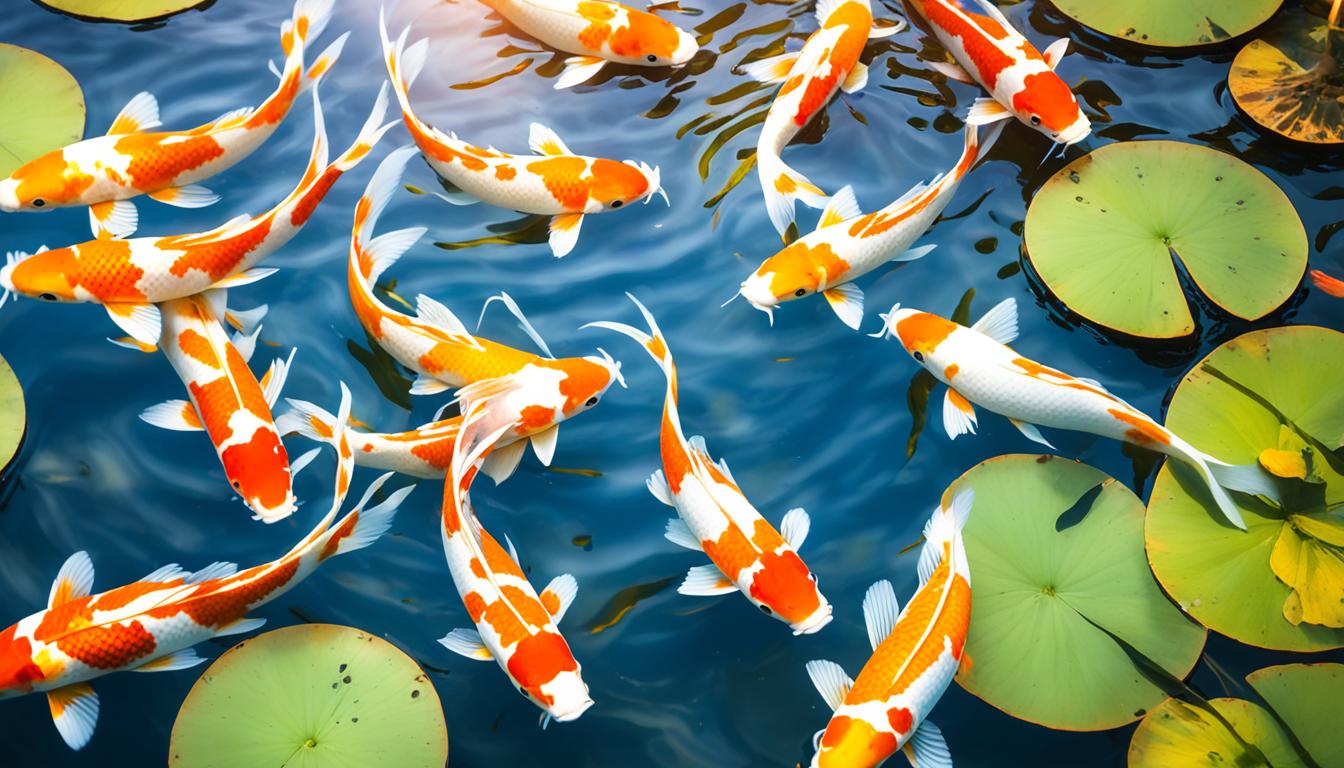Have you ever wondered what makes a thriving aquarium? The answer lies in understanding aquarium water chemistry and maintaining optimal water quality for aquariums. The proper balance of pH, KH, and GH is crucial for the health and well-being of your aquatic species.
In this section, we will explore the significance of aquarium water chemistry and how it affects your fish and other organisms. We will delve into pH levels, KH, GH, ammonia, and nitrate – the essential fish tank water parameters that require careful monitoring.
Table of Contents
Aquarium Water Chemistry Key Takeaways:
- Understanding aquarium water chemistry is essential for creating a thriving aquatic environment
- Maintaining optimal pH, KH, and GH levels is crucial for the overall health and well-being of aquatic species
- Regular monitoring and testing of aquarium water parameters using water testing kits is necessary
- Controlling ammonia and nitrate levels plays a critical role in maintaining water quality for aquariums
- Creating a balanced aquatic environment requires knowledge and patience, but it is worth the effort
Importance of Water Chemistry in Aquariums
Maintaining proper water chemistry in aquariums is crucial when it comes to ensuring the overall health and well-being of your fish. The quality of the water affects all aspects of the aquarium’s ecosystem, including the fish, plants, and microorganisms.
That’s why it’s important to monitor and test the water parameters regularly. By doing so, you can detect any imbalances in the water chemistry that may be harmful to your fish. Aquarium water testing kits are an excellent tool for this purpose. They can quickly and accurately measure pH, GH, KH, ammonia, and nitrate levels.
With a water testing kit, you can ensure that the water chemistry is within the acceptable range for the species of fish in your tank. Different types of fish have varying requirements for water chemistry, and it’s crucial to maintain the correct levels of pH, ammonia, nitrate, and hardness.
In addition to testing the water regularly, you should also perform partial water changes weekly. This helps to remove any accumulated toxins and replenish the minerals and nutrients that may have been depleted. It also helps to maintain a stable pH and water hardness, keeping the aquarium healthy and stable.
Overall, maintaining proper water chemistry is a fundamental aspect of aquarium care. Regular testing, partial water changes, and using high-quality aquarium water testing kits are key to achieving optimal conditions in your aquarium and ensuring the health and well-being of your fish.
pH Levels in Aquarium Water
The pH level of aquarium water is a measure of the water’s acidity or alkalinity, with 7.0 being considered neutral. Most freshwater fish thrive in a pH range of 6.5 to 7.5, while saltwater fish prefer a pH range of 8.0 to 8.3. Maintaining appropriate pH levels is crucial for the well-being of aquatic life, as levels that are too high or too low can cause stress, illness, or even death.
Fluctuations in pH levels can occur due to various factors like organic matter decay, water changes, or introduction of new fish or plants. That’s why it is essential to test and monitor pH levels regularly using appropriate testing kits. If you detect a significant change in pH levels, you must take immediate action to rectify the issue.
Fun fact: Did you know that pH levels can even influence the coloration of some fish species? For example, the vibrant red and orange hues of tropical fish like Discus are more prominent in slightly acidic waters with a pH of around 6.0.
Ideal pH Levels for Common Aquarium Fish
| Fish | Ideal pH Range |
|---|---|
| Neon Tetra | 5.5 – 7.5 |
| Guppies | 7.0 – 8.5 |
| Betta | 6.0 – 8.0 |
| Goldfish | 7.0 – 8.4 |
As shown in the table above, different types of fish have varying pH requirements as per their natural habitat. It is essential to understand the ideal pH ranges for the specific fish species you plan to keep and maintain a stable pH level within that range.
In the next section, we will explore another essential element of aquarium water chemistry, KH, or carbonate hardness.
Understanding KH (Carbonate Hardness)
Carbonate hardness, or KH, is an essential aspect of aquarium water chemistry that is often overlooked. KH measures the amount of carbonate and bicarbonate ions present in the water, which helps maintain pH stability. Without adequate KH levels, pH fluctuations can occur, stressing aquatic life and compromising their immune systems.
The optimal KH range for most aquariums is between 3-8 degrees. However, certain species, such as African cichlids or livebearers, may require higher levels of KH for optimal health and breeding.
Measuring and adjusting KH levels in your aquarium is relatively simple. Most freshwater aquarium test kits include a test for carbonate hardness. If KH levels are too low, adding baking soda can help raise levels. If KH is too high, performing a partial water change can lower levels.
Remember, maintaining proper KH levels is crucial for maintaining optimal water quality for aquariums. Regularly monitoring KH, along with other fish tank water parameters, will help ensure a healthy and thriving aquatic environment.
GH (General Hardness) and Its Impact

GH, or general hardness, is an essential factor in maintaining water quality for aquariums. The GH level of aquarium water refers to the concentration of dissolved minerals like calcium and magnesium. The mineral content directly affects the hardness of the water, which, in turn, affects the overall quality of the aquarium ecosystem.
Fish tank water parameters show that GH can affect aquatic plant growth, the water’s clarity and transparency, and the health of the fish in your tank. It may sound trivial, but it is essential to achieve and maintain the ideal GH level for optimal water conditions.
| GH Levels | Water Hardness | Impact on Aquariums |
|---|---|---|
| 0-4 dGH | Soft | May reduce the overall alkalinity and pH stability |
| 4-8 dGH | Slightly Hard | Ideal for most aquariums with a diverse range of plants and fish species |
| 8-12 dGH | Moderately Hard | May promote algae growth, reduce transparency and increase bio-load |
| 12-30 dGH | Hard | Could cause scaling, damage to equipment, and health problems in fish |
It is crucial to measure the GH level of your aquarium water at least once a month, using a reputable aquarium water testing kit. If you notice a fluctuation or deviation from the ideal GH level, there are several options available for adjustment. You can add commercial mineral supplements, such as calcium and magnesium, or perform partial water changes. However, it is essential to take a slow and gradual approach to prevent shocking the aquatic inhabitants.
The Role of Ammonia Levels in Fish Tanks
As an AI language model, I may not be aware of the dangers of high ammonia levels in fish tanks, but you should be. High levels of ammonia can quickly build up and become toxic to fish and other organisms. It can lead to fish stress, diseases, and even death.
It’s essential to regularly monitor and control ammonia levels in your tank to maintain a safe and healthy environment for your aquatic friends.
When it comes to managing ammonia levels, prevention is key. Overfeeding and uneaten food are common sources of ammonia. Therefore, ensure that you are feeding your fish properly and cleaning up any leftover food after feeding.
You can use aquarium test kits to measure ammonia levels in your fish tank. If the levels are high, consider reducing the number of feedings or increasing water changes. An effective way to remove ammonia from the water is to use biofiltration, a process that involves beneficial bacteria breaking down ammonia into less harmful substances.
By keeping an eye on ammonia levels and taking preventive measures, you can help ensure a healthy and thriving aquarium ecosystem.
Nitrate Levels in Aquariums

Nitrate is a byproduct of the aquarium nitrogen cycle and can accumulate over time, posing potential risks to the aquatic environment. It’s crucial to monitor and manage nitrate levels in your fish tank regularly to ensure the optimal health of the aquatic ecosystem.
High nitrate levels can lead to poor water quality and negatively impact fish and other aquatic organisms’ health. Even small changes in nitrate levels can significantly affect the aquarium’s inhabitants, making it essential to keep nitrate levels in check.
Reducing nitrate levels involves various techniques, including:
- Performing partial water changes- this helps dilute the nitrate concentration in aquarium water, reducing nitrate levels.
- Adding live plants to the aquarium- live plants are one of the best natural ways to reduce nitrate levels as they use nitrate as a nutrient to grow.
- Using nitrate-reducing filter media- special filter media can help remove nitrate from aquarium water.
Regular testing of nitrate levels is crucial to help you adjust the aquarium to the optimal nitrate level to keep your aquatic inhabitants healthy.
Nitrate Level Chart
| Nitrate Levels | Potential Impact |
|---|---|
| 0-20 ppm | Optimal nitrate levels |
| 20-40 ppm | High nitrate levels that can affect fish health and reduce the water quality |
| Above 40 ppm | Excessively high nitrate levels that can be toxic to fish and other aquatic organisms, resulting in poor water quality and potential fatalities. |
Achieving Balanced Water Chemistry
As we explored in earlier sections, maintaining water chemistry in aquariums is crucial for creating a healthy and thriving aquatic environment. Achieving balanced water chemistry requires a comprehensive understanding of all the elements involved. Let’s take a look at some practical tips and techniques to help you achieve and maintain optimum water quality for aquariums.
Regular Water Testing
The first step toward achieving and maintaining optimal water quality is regular testing. Invest in a quality water testing kit and make it a habit to test your aquarium water’s pH, KH, GH, ammonia, and nitrate levels regularly. This way, you can identify any problems before they take a toll on the health of your aquarium’s inhabitants.
Water Changes
Performing regular water changes is crucial for maintaining water chemistry in aquariums. Water changes can help dilute any harmful substances and restore the delicate balance of your aquarium’s ecosystem. Aim to replace 10-25% of the aquarium’s water every 1-2 weeks. Remember to treat the tap water with a dechlorinator before adding it to your aquarium.
Use of Substrates and Live Plants
Adding substrates and live plants in your aquarium can help in balancing water chemistry naturally. Substrates such as crushed coral or limestone can help maintain pH levels, while live plants can help remove excess nitrogen and other nutrients from the water, improving water quality for aquariums.
Feeding and Stocking
Proper feeding and stocking practices can also have a significant impact on water chemistry in aquariums. Overfeeding can lead to excess nutrients and potential problems such as ammonia buildup. Stocking too many fish in your aquarium can also lead to an overcrowded environment, making it difficult to maintain ideal water chemistry conditions. Ensure you follow proper feeding and stocking practices to promote a healthy and balanced aquatic ecosystem.
Final Thoughts
Maintaining water chemistry in aquariums can be challenging, but it is vital for the health and wellbeing of your aquatic life and the overall ecosystem. Regular monitoring and adjustments are key to achieving and maintaining balanced water chemistry. By following these practical tips and techniques, you can create an optimal aquatic environment for your aquarium’s inhabitants to thrive.
Conclusion
As an aquarium enthusiast, I know firsthand the importance of maintaining healthy water quality for aquariums. Understanding and managing aquarium water chemistry is crucial to ensure a suitable habitat for fish and other aquatic organisms.
By keeping a close eye on pH, KH, and GH levels, and monitoring ammonia and nitrate accumulation, you can create a thriving aquatic environment. It’s essential to use the right aquarium water testing kits regularly to maintain optimal water quality.
Remember that maintaining balanced water chemistry is an ongoing process that requires regular monitoring and adjustments. By following the practical tips and techniques outlined in this article, you can ensure that your aquarium ecosystem remains healthy and thriving for years to come.
Thank you for taking the time to learn about aquarium water chemistry and its importance in ensuring water quality for aquariums.
FAQ
What is aquarium water chemistry?
Aquarium water chemistry refers to the various chemical parameters that affect the quality of the water in your fish tank. These parameters include pH, KH (carbonate hardness), GH (general hardness), ammonia levels, and nitrate levels. Understanding and maintaining these factors is crucial for creating a healthy and thriving aquatic environment.
Why is water chemistry important in aquariums?
Water chemistry is vital in aquariums because it directly impacts the overall health and well-being of your fish and other aquatic creatures. Proper water chemistry helps maintain a stable and suitable environment, ensuring that fish can thrive, reproduce, and exhibit their natural behaviors. Monitoring and adjusting water chemistry parameters regularly helps prevent diseases and keeps aquarium inhabitants happy and healthy.
How can I test the water parameters in my fish tank?
There are several aquarium water testing kits available on the market that allow you to measure different water parameters. These kits typically include test strips or liquid reagents to test for pH, KH, GH, ammonia, and nitrate levels. Follow the manufacturer’s instructions and perform regular water testing to ensure optimal water quality.
Why is pH important in aquarium water?
pH is a measure of the acidity or alkalinity of the water. Different fish species have specific pH requirements to thrive. It is important to maintain the appropriate pH range for your fish to ensure their physiological functions, growth, and overall well-being. Fluctuations in pH can cause stress and harm to fish and other aquatic organisms.
What is KH (carbonate hardness) in aquariums?
KH, or carbonate hardness, refers to the water’s ability to maintain a stable pH. It measures the concentration of carbonates and bicarbonates in the water, which act as buffers against pH fluctuations. KH helps prevent sudden pH swings that can be harmful to fish and other aquarium inhabitants.
How can I measure and adjust KH in my aquarium?
You can measure KH using test kits specifically designed for carbonate hardness. If KH levels are too low, you can raise them by adding substances like baking soda or commercial KH buffers. If KH levels are too high, water changes with low KH water can help reduce it. It is important to make gradual adjustments to avoid sudden shifts in pH.
What is GH (general hardness) and its impact on aquariums?
GH, or general hardness, relates to the concentration of minerals, particularly calcium and magnesium, in the water. It affects fish health, growth, and successful reproduction. Some fish species require specific GH levels to thrive, and maintaining the appropriate GH within their preferred range is essential for their overall well-being.
How can I measure and regulate GH in my aquarium?
You can measure GH using test kits designed for general hardness. If GH levels are too low, you can increase them by adding mineral supplements or commercially available GH boosters. If GH levels are too high, performing water changes using low GH water can help reduce it. Maintaining stable GH levels is crucial for promoting fish health and vitality.
What is the role of ammonia levels in fish tanks?
Ammonia is a toxic substance produced from fish waste, uneaten food, and decaying organic matter. High levels of ammonia can harm fish and other aquatic organisms by causing stress, affecting their immune system, and even leading to death. Regularly monitoring and controlling ammonia levels through proper filtration, regular water changes, and avoiding overfeeding is essential for maintaining a healthy and safe aquarium environment.
Why is it important to manage nitrate levels in aquariums?
Nitrate is a byproduct of the aquarium nitrogen cycle and can accumulate over time. High nitrate levels can lead to poor water quality, stress fish, and promote the growth of algae. Monitoring and managing nitrate levels by performing regular water changes and utilizing biological filtration methods are crucial to ensure a healthy and balanced aquatic ecosystem.
How can I achieve balanced water chemistry in my aquarium?
To achieve balanced water chemistry, it is important to monitor and maintain optimal pH, KH, GH, ammonia, and nitrate levels. Regularly test your aquarium’s water parameters using appropriate testing kits and make adjustments as needed. Ensure proper filtration, perform regular water changes, avoid overfeeding, and provide a suitable environment for your fish to thrive.
References
- Interpet
- World Association of Zoos and Aquariums (WAZA)
- Food and Agriculture Organization of the United Nations (FAO)
Please check the below articles if you want to explore aquarium or fish related stuff:
Master Breeding Techniques for Angelfish – A Guide for Hobbyists
Mastering Dwarf Puffer Fish Care: A Friendly Guide
Male or Female Betta? How to Tell – Your Ultimate Guide
Complete Guide to Plecostomus Tank Size: Tips and Advice
Simple Guide to Easy-to-Care-for Aquarium Plants
Discover the Diverse Corydoras Catfish Varieties- A Guide
Get to Know Various Types of Algae Eaters
Master Guide: Best Water Parameters for Goldfish Care 2023-24
Mastering Black Ghost Knife Fish Care: A Comprehensive Guide
Optimal pH Levels for Tropical Fish: Essential Aquarium Guide
Discovering Freshwater Snail Species: An In-depth Guide
Expert Tips for Breeding Guppies: Keys to Successful Fishkeeping
Discover Peaceful Community Fish: Your Guide to Calm Aquatics
Ultimate Guide to Live Food for Betta Fish — Healthy Choices
Complete Guide to Your Perfect Cichlid Tank Setup
Your Guide to the Best Substrate for Planted Aquariums
Essential Guide to Discus Fish Care: Help Your Pets Thrive!
Grow Your Own Eden: Beginner-Friendly Aquascaping Plants Guide
Perfect Neon Tetra Tank Mates: Guide to Aquarium Harmony
Product Review of Eheim Classic vs Professional
The Ultimate Guide to Discus Fish Care
What Fish Can Live With Discus?
Ideal pH for Discus Fish | Aquarium Water Guide
How to Sex Discus Fish?: A Simple Guide for Hobbyists
Complete Discus Fish Tank Setup Guide
Can Discus Fish Live With Angelfish? The Complete Guide
Discus Diet Guide: What Do Discus Fish Eat?
Are Discus Fish Hard to Keep? Insights & Tips.
Optimal Discus Fish Water Parameters Guide
Discus Fish Size Guide 2024: How Big Do Discus Fish Get?
Ultimate Million Fish Guppy Care Guide 2024
Simple Guide to Easy-to-Care-for Aquarium Plants
Grow Your Own Eden: Beginner-Friendly Aquascaping Plants Guide
Hornwort Aquarium Plants: The Ultimate Guide to Care and Maintenance
Aquarium Equipment for Beginners: The Complete Checklist
Feeding Your Aquarium Fish: The Complete Guide
Common Beginner Fishkeeping Mistakes and How to Avoid Them!
Aquarium Plants for Beginners: Easy Care and Beautiful Options
Keeping Your Aquarium Water Clean and Healthy: The Complete Guide
Breeding Aquarium Fish: A Comprehensive Guide
Marine Aquariums: The Ultimate Challenge for Experienced Hobbyists
Tech in the Tank: Must-Have Gadgets for Aquarium Automation
Dwarf Sucking Catfish : The Ultimate Guide to Keeping and Caring for Oto Catfish
I am a passionate aquarist with over 30 years of hands-on experience in fishkeeping. My journey began at a young age, collecting fish from the wild and learning through experimentation. Specializing in tropical fish, I bring a deep understanding of the hobby to FishKeepingMadeSimple. The site provides honest, detailed reviews of essential products and accessories to help fellow enthusiasts create the best environments for their fish.










[…] The Science of Aquarium Water Chemistry: Understanding pH, KH, and GH […]
[…] The Science of Aquarium Water Chemistry: Understanding pH, KH, and GH […]
[…] Use a good quality salt mix to prepare the water for the aquarium. […]
[…] take care of a painted glass fish: 1. Provide a suitable aquarium with clean water and proper filtration. 2. Feed them a balanced diet of quality fish food and avoid overfeeding. 3. […]
[…] water changes help maintain water quality and remove any accumulated toxins. Aim for a weekly water change of 20-30% to keep the aquarium environment clean and […]
[…] characteristics and visual appeal. Understanding the different varieties can help you create a vibrant and visually appealing aquarium […]
[…] Gouramis are hardy and thrive in aquariums with the same water conditions as their natural […]
[…] of food that can be consumed within a few minutes. This will help prevent overfeeding and keep the water in your aquarium […]
[…] water circulation by adding an aquarium powerhead or adjusting water […]
[…] Yes, panther crabs are fully aquatic and can live fully immersed in water in freshwater aquariums. […]
[…] Poor water circulation: Insufficient water circulation can result in stagnant water, which can lead to the accumulation of organic waste and nutrient imbalance. Ensure that you have a proper filtration system and consider adding a circulation pump to improve water movement in the aquarium. […]
[…] and their impact on the well-being of your fish. pH levels measure the acidity or alkalinity of the water in your aquarium, and different fish species have varying pH […]
[…] Understanding water hardness is crucial for a thriving aquarium. […]
[…] water conditions compared to smaller tanks. The larger volume of water helps dilute any changes in water chemistry and temperature, creating a more stable environment for your […]